The webcomic creator is never far from their audience. Be it through social media, public email addresses, Discord servers, or simply the comments section beneath a page, there is a rapport and a conversation that is developed that is unique to the medium. We’re continuing those conversations here, albeit a little more formally, by interviewing webcomics creators to pick their brains about craft, storytelling, and their personal experiences with the medium.
Thom Zahler is no stranger to Multiversity, having previously swung by to talk about his last webcomic, “Warning Label”, back in 2018. Now we’re here to take a long look at his many books, including the recently Ringo-nominated “Love and Capes: In the Time of Covid” as well as the webcomic “Cupid’s Arrows.” We talk romance comics, webtoon, licensed comics and more. I wonder if this would’ve been better for February?
Thanks again to Thom for interviewing with us!
To get us started, what was your first experience with Webcomics?
Thom Zahler: I guess my first run at them was when I designed “Love and Capes.” My friend Bill Williams of Lone Star Press and I had talked about them and figured out how to design them to fit on a screen, so the top half of a normal comic. So when I designed LNC, I wanted a print comic that I could repurpose as a webcomic, hence the four-panels-and-a -beat structure that I came up with.
I participated in DC’S Zuda experience with Bill and then, about four years ago, Tom Akel, the then-editor at Webtoon and I met at Baltimore Comic-Con and started talking about bringing me on. That led to “Warning Label” and then “Cupid’s Arrows.”
Oh wow. I had no idea about DC’s Zuda. Could you speak on that a little?
TZ: It’s a little hazy, but DC had a program for people to submit content. I think we did an eight “screen” comic, written by Bill and drawn by me called “The Adventures of Melvin Blank.” DC then would select eight contestants a month or so and have them compete with one winner based on user likes. I think David Gallagher’s “Full Moon” came out of there.
It was fun to do and definitely reflected that whole half-page webcomic thing that was going around at the time. And it was a decent way to approach it.
So you’ve been pretty familiar with corporate, for lack of a better word, webcomics as well as more indie publishing.
TZ: Yeah, I suppose so. To quote Brisco County, Jr., I’m always looking for the coming thing, and I was open to the possibility of webcomics before they broke so big. I try to remember that I’m not always the audience for everything and even if it’s not my preferred format, it might be someone’s, so why not try?
I was always looking for a way to do more things and I was paying attention to what people were doing to see how to implement it. For a while I thought the iPad was going to be The Thing because people can read almost comic-size on it. But there’s a definite strain of one-size-fits-all that you need to watch against. So I keep that in mind, too.
I can imagine it would’ve been difficult to keep planning for print and half-page and scrolling all at the same time. Are there any formats you prefer to create for or do they each have their strengths and weaknesses? Do you have particular projects you can only see in one format i.e. whole page, Webtoons scrolling, 4-panel strip, etc.?
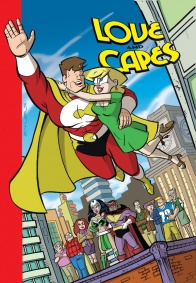
TZ: So, for purposes of this discussion, I’m going to count traditional comics/full screen PDFs as one and Webtoon’s infinite scroll as another.
They’ve both got advantages and disadvantages. It’s kind of like hopping between TV and film or half-hour and full-hour… whatever. Print does really well with vistas, since infinite vertical scroll is constrained by the width of the phone. Anything that needs to have a sense of horizontal space, and maybe some action, which I find harder to do in scroll format because changing the panel widths is part of that for me.
Continued belowScroll works great for character-focused things. And it’s cool to have as much real estate as you need to work with. I don’t have to hit a page count. It’s the satisfying chunk math that gets different. I think any dollop of comics needs to hit that “satisfying chunk” amount. When you watch a TV show, its got a beginning, middle and end, even if it’s continued. It doesn’t just stop in the middle. There needs to be a sense of resolution or cliffhanger or whatever. But it needs to be satisfying. So, I think scroll is better for smaller chunks. “Warning Label” and “Cupid’s Arrows” were about 5-7 pages of a traditional comic, but each chapter felt like a chapter. Something like “Time and Vine” or “Long Distance” needed larger space to tell the story so comics work better for that since it was more of an issue-sized dollop. Either can work, it’s just where you put your natural breaks.
To relate to film again, if you watch a cinematic movie on basic cable, the commercials feel like an interruption. I remember watching Star Trek II and they interrupted Khan’s “Where is the Enterprise” and came back from break to see the Enterprise on the other side of the planet.
Meanwhile, watch any episode of Legends of Tomorrow or whatever and whenever they go to break, it feels like a break. So format-wise, it’s figuring out where those things are to tell the story properly.
And you were doing those Webtoons on a weekly schedule. Did you find it was comparable work-wise to doing an issue of “Time and Vine” or was the chunk nature a little harder since each 5-7 pages had to resolve in a way 5-7 random pages of an issue don’t?
TZ: That all happens in the writing process. Tom Akel was my sherpa there, and when he described it as 5-7 pages, I knew what I was writing for. So I took my giant pitch document and started cutting it up into what I thought were the properly sized chunks.
One of my mutant powers is that I have a pretty good metronome in my head. When I write a TV script, I’m usually within a couple pages of where it needs to be. When I write a comic script, I have a good feel for what 20-22 pages is. I think I’ve just consumed so much media that I think in those bursts.
With “Warning Label,” I made it into right-sized chapters and knew I had to end on the right kind of beat. So, things may end with a more dramatic kiss so they feel like a chapter end rather than in a longer form comic where the scene might just cut away.
And I wasn’t perfect, either. Webtoon let me expand out the story early on, so I definitely added to it. Originally it was supposed to be 26 chapters and it wound up at 39. I think I would have been just a couple over if I had followed my original plan. There were scenes like when Jeff’s niece meets Danielle for the first time that I had two chapters of content in one chapter’s space. But for the most part I was pretty accurate.
And for me, the story is the story is the story. You service that. So while I expanded scenes and let things breathe, I was conscious to never pad. The one exception to that was I added a chapter so the finale would post on Valentine’s Day. And even that chapter wasn’t so much filler as a chance to really hammer the awkwardness those characters were experiencing. But without that chapter, it would have been interspersed in the bigger scenes, not a focus.
So “Warning Label” was always planned as a mini, to borrow the parlance of print comics, over an ongoing(ish) like “Love and Capes?”
TZ: Very much so. “Warning Label” had a definite end and that was unavoidable. There was only so long I could keep emotionally abusing Danielle. And I couldn’t figure out a way to give her ANOTHER label, or make someone else go through the same thing without it feeling derivative.
Continued belowBecause I’m often an independent one-person creator, I always think in terms of endings. I don’t want things to just peter out, they need to resolve. With “Love and Capes”, I’d planned on that being three trades. It wound up four (I split the newlywed and pregnancy years). And then I didn’t come back to it until I had an ending worth coming back for.
One of my earliest projects was a book called “Raider” that was supposed to be a multi-volume opus. I made all my mistakes on that book and I don’t know that I’ll ever finish it. But because of that experience, I do much smaller chunks of story so that they actually end satisfyingly.
I’m guessing it’s killing you that “Cupid’s Arrows” hasn’t gotten to reach that ending yet, then, because I know it’s killing me haha.
TZ: Oh my goodness, yes! I never would have ended on THAT note if I knew that was my last season. And even when I did know, I couldn’t speed up the ending enough. I had to end where I planned. The story is the story.
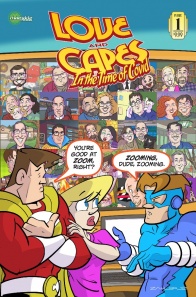
That said, one of the things I did during the pandemic was to launch a Patreon where I posted my “Love and Capes: In the Time of Covid” comic with my heroes dealing with the pandemic BUT FUNNY! Because of that four panel beat structure, I could post a page a week and have it feel readable. So, as I’ve wrapped that and I’m moving on to new things, the plan is to do “Cupid’s Arrows” season three (and probably four) on there. It’ll be a chapter a month, since I can’t keep up the Webtoon pace without the same remuneration, but then I can slowly build enough to collect and finish that story.
I’ve got the first chapter thumbnailed already! Promise!
Can’t keep up Webtoons pace without Webtoons money. This is a bit inside baseball but what’re the rights situations like with Webtoons? I’ve talked with other creators and each series seems to have a slightly different deal.
TZ: Yeah, they’ve been around long enough that things change. So, for me, I own “Cupid’s Arrows” outright. I had a period of time where I had to wait before continuing on my own. But now it’s all mine and I can do whatever I want.
I sold a small portion of “Warning Label” to Webtoon. So they’re attached to whatever I do with it next, but I own a controlling interest, for lack of a better term.
That makes sense. It’s just weird with comics to consider the way split ownership works between publishers and creators. Because you’ve done some work for hire (“My Little Pony,”) and some of your own stuff but not quite creator owned (“Time and Vine”) through IDW, correct?
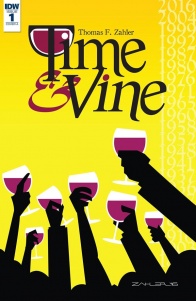
TZ: So, all my IDW work, with the exception of “My Little Pony,” “Star Trek” and any of their other licensed stuff is actually creator-owned. We have an agreement that covers how long they have the publishing rights, but I own everything else. So, if Richard Curtis wants to make a “Time and Vine” movie, he just needs to come to me. It’s all different deals and what works best for you and keeping a mix. I sometimes say that “My Little Pony” pays for my house now and “Love and Capes” will pay for my house later.
I try to be pretty sanguine about the things that I sign and pay attention to what I’m giving away and what the tradeoffs are. So, for instance, some of the characters I created for the “My Little Pony” series have appeared in the game. I don’t get anything for that. But I knew when I did my job that Hasbro owned everything. And the trade-off has been working on a big name property that got me brought out to lots of shows and raised my profile to the point that I got more and different jobs that I might not have gotten self-publishing my one little book.
Even still, it’s not without risks. I can’t imagine that David Aja thought that his “Hawkeye” covers were going to be so much a part of the visual language of the TV show. And how could you? That kind of thing has never happened before (that I know of). I’m sure he’s getting paid for adapting his work on the comic, but the cover and designs are a different thing. It’s relatively unexplored ground. Disney/Marvel is probably contractually in the right, but when you see something like that, you kind of want them to step up and say “We’re doing more with this than either of us thought so here’s what we’re going to do for you.”
Continued belowIt’s a messy thing. I know people who say “Oh, they should just do X” about whatever situation but there are consequences and precedents that come with doing that. The right thing is not always the legal or the best thing to do. And as there’s a blending between so much media, that’s something we’re all going to have to navigate and it’ll be choppy waters.
Especially as more and more comics properties make their way to other media in these ways. To take a bit of a step to the side on this and go back to your work, many of your titles center romance and yearning and the messiness therein. What has drawn you to the genre that you return in new and different ways across your works?
TZ: It was two things. One is marketing. “Hit ‘em where they ain’t.” If I try to do a standard superhero book, I’m in the same water as DC and Marvel and they kind of dominate that space. At best, I’m just another guy in that pool. I think I’d be good at it, but it’s hard to get noticed. But when you do something that they’re not, like a spy book which I did with “Raider,” or a romance book about a couple actually being happy, that’s wildly different and you get a lot more notice. So I figured I’d serve the audience that they weren’t.
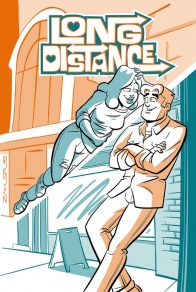
The other is that, when I was doing that spy book, I wrote some characters that had a charming will-they-or-won’t they banter and I liked it so much that when I was figuring out what to do next, I decided I wanted to play to that. I found I was more interested in the in-between moments than the action moments. That led to me writing a romantic comedy spec script for this Bravo competition show called Situation: Comedy. That’s where the original “Long Distance” script started. The other idea I had was “Love and Capes.” I’m glad I held off on that.
So now, I try to think about what I would do that people who like my stuff would go “Oh, that would be interesting to see him do.” I try to expand the circle of what I’m doing, of course. “Love and Capes” was never about “will they make it”, it was about HOW they make it. “Long Distance” was more the start of a relationship. “Time and Vine” is about a lot of different love relationships and how they affect us. And so on.
I mean, I think I have a killer horror story in me, but if I announced “A horror book from Thom Zahler” people would go “huh”. I announce a series about a bantery couple of Cupids making matches and people say “Oh, I think he’ll do something cool with that.”
I mean… hopefully they do. Ha ha!
I mean, you never know until it’s out there. What are some media that serve as inspiration for your works? Be it generally or for specific titles.
TZ: So, I had a strong dalliance with Aaron Sorkin stuff. I loved SportsNight and West Wing. Again, that was big banter stuff. But that kind of melodic dialogue cadence was really appealing to me.
I love older comic strips, too. “Bloom County” and “Calvin and Hobbes” remain giant inspirations to me.
I was fortunate enough to be friendly with Darwyn Cooke and he was an absolute genius when it came to comics. He had a way of making ANYTHING work in comics. He could do superheroes, romance, noir, anything. And his “New Frontier” is always in my studio as inspiration.
And right now, Ted Lasso, because that just resonates with me in a molecular way.
Your banter game is very strong. It’s one of the reasons I started following your work, actually. “Time and Vine” was recommended to me by another contributor at Multiversity and I loved it. In a separate, but related, question, how do you primarily work? Is it all digital, a mix of physical and digital? Has it changed over the years?
TZ: It’s changed a lot. I am very old.
When I started, everything was all traditional. The first four volumes of “Love and Capes” were drawn and inked by hand. I always colored on a computer, and I letter on a computer, too. (Though I learned that traditionally, too.) These days, I’m working on a mix of iPad and my Cintiq. The iPad is kind of a “90% machine” to me. I can get almost all the way there, and then I need to ink on the Cintiq to make it look consistent.
Continued below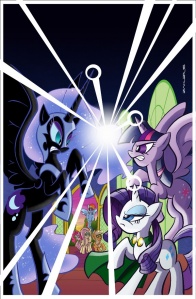
That said, I do make sure to break out the traditional when I need to. I make sure all my covers are done traditionally so I have original art to sell. This is especially a big thing with “My Little Pony.” Resale of art is part of the whole structure.
These days, I thumbnail anywhere and anyway I can. I’ll lay things out on the iPad or the Cintiq depending on if I’m working at a convention or in my studio. Inks on Cintiq. Colors and letters on Cintiq. I draw in Procreate on the iPad, Clip Studio on the Mac. Colors in Photoshop. Letters in Illustrator.
But the big thing to me is that they’re all just tools. I’m not precious on that. I’m the thing that knows how to draw, so whether I’m working with a Col-Erase pencil or a stylus, it’s all the same since I’m the one who has to drive it.
It’s a constantly evolving process. You think it’ll change in any meaningful way in the next five years?
TZ: Goodness, I hope so! There’s a thing that happens to artists, kind of an “old man drawing” that clicks in when you get too comfortable. I want to keep giving myself different problems and challenges to solve. There’s always been something different in each project. There was the color-as-place thing in “Long Distance,” a limited palette in “Warning Label,” a much longer form story and really taking advantage of vertical scroll in “Cupid’s Arrows.”
It’s like I say that I can never get a tattoo. Because if I did, it’d be something I drew and I hate everything I drew six months later because I get better. I hope.
As for what changes, I don’t know? I try to make sure I get better with poses and expressions and colors and just keep moving forward and finding different and better ways to tell the story.
Is there any part of the comics process that you dislike? Or that’s the most challenging and you wish it was either not there or that there was a better way?
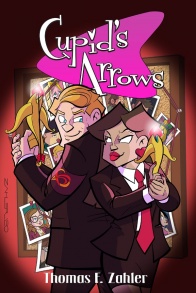
TZ: Mostly, I like every part of the process, but I don’t necessarily like it at the time. I like coloring one page. Coloring twenty-four can wear you down.
But, without getting too flippant, the things that challenge me are the selling, which I think I’m decent at but it’s still a grind. It’s hard to flip back and forth from salesperson to creator. And the other challenge is the time. Like, right now, contemplating starting another 24 chapters of “Cupid’s Arrows” is just daunting. It’s like climbing a mountain. You might like doing it, and really like having done it, but those first couple of steps are hard to start because you know how many steps are in front of you.
Is that the part of conventions you dread – the constant mix of selling and conversing – in the lead up to them?
TZ: I actually love the conversing. So much of my life is spent in an 8×20 room by myself with a bunch of podcasts that the reaction that people give me is an energy I need to keep going. Between little kids coming up being super-excited by meeting someone who works on My Little Pony to Webtoon fans coming up literally crying because the series meant so much to them… that’s part of why I do this. Heck, it’s THE reason I do this.
Now, it is an energy drain. After the show I’m pretty spent. It’s like the shawarma scene at the end of Avengers. But I’m still glad I did it.
The part that’s my least favorite, I think, is the math. Trying to figure out what to bring, how much to bring, how to get it there, how much it weighs. That nitty-gritty is my least favorite part. And the great thing about working for yourself and pursuing the thing you believe you were put on this world to do is that there’s an enjoyment to even the crappy parts because it all goes to the bigger goal.
All that said, I’d kill to have an Alfred or a Jarvis who just makes sure that all my stuff shows up in whatever city I’m in and everything is all set up so I can just sit down and make things and meet people.
Continued belowAre there any characters or books that seem to stick with fans more than others?
TZ: Amazonia was not supposed to be a regular character in “Love and Capes.” She was just there for the two pages of jokes in issue one. And there was such a reaction to her, I knew I had lightning in a bottle and had to keep going with her. Now I can’t imagine the series without her.
I think “Love and Capes” is my calling card. It’s what people know me for, and it’ll be in all my biographies for the rest of my life. We’re intertwined just because I’ve done it for so long.
“Warning Label” is the one that resonates with people. I think there’s a raw emotional core to that which really hits people. When I mention people tearing up when they talk to me, it’s always over “Warning Label.” I’m very proud of it, and some of the solutions and storytelling in it are some of my best work.
Last, “Time and Vine” appropriately has this weird magic to it. It is the only thing on my table that ever sells itself. There’s something about that yellow cover and the concept that hooks people in a way that I don’t understand.
“Love and Capes” is my bread and butter. “Warning Label” is this one close-to-perfect thing that exists on its own. But “Time and Vine,” I feel like that’s got a life of its own and will do things I can’t even imagine.
OK. Last question. What are some webcomics you would recommend to fans of “Warning Label” and “Cupid’s Arrow?” Or comics for any of your creator-owned works?
TZ: “Let’s Play” and “#Blessed” are two that really appeal to me. One’s a long form romance in a gaming world and “#Blessed” is a crazy high-concept story executed brilliantly. If you like my stuff, you’ll like those.
Same goes for Katie Cook’s “Nothing Special.” That’s magic on screen.
Beyond that, I’m sad to say I don’t read anywhere near as much as I want to. I feel like I’m always making something and then just burnt out when the time comes to relax and read. A lot of what I turn to are the older bronze age comics that I grew up with because they’re so compact and pound-for-pound fun. They were serious, but not too serious.
Oh, and I know it’s not a comic, but Ted Lasso. It really is as good as people say it is, and it is thematically resonant with everything I do.






